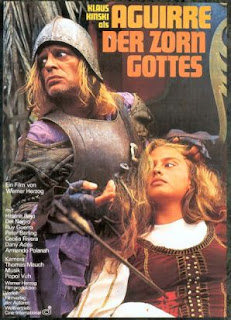Aguirre, the Wrath of God
 Daniel Grann's book, The Lost City of Z, makes a brief mention of Lope de Aguirre, the conquistador who went on a mad expedition to find El Dorado, and was the subject of Werner Herzog's classic film, Aguirre, the Wrath of God. I had never seen that film before (I'm woefully behind of Herzog's pictures), so thought it was a good chance to bump it up my Netflix queue.
Daniel Grann's book, The Lost City of Z, makes a brief mention of Lope de Aguirre, the conquistador who went on a mad expedition to find El Dorado, and was the subject of Werner Herzog's classic film, Aguirre, the Wrath of God. I had never seen that film before (I'm woefully behind of Herzog's pictures), so thought it was a good chance to bump it up my Netflix queue.The film, from 1972, starring the wild-man Klaus Kinski in the title role, has gained legendary stratus, and for good reason. It's a feast for the senses, but not in the usual sense. Yes, the lush foliage (the film was shot on location in Peru) is made good use of, but there's something more elemental about the way it looks. It's dreamlike in some ways, but in some ways it's brutally realistic.
The film begins with a procession down a mountain. It's 1561, just after Pizarro has conquered the Incas. The Spanish have heard the Indians speak of El Dorado, a city full of riches, so they set down the Amazon to search for it. They begin by descending from the Andes, where they are up so high that they need to pass through clouds on the way down. This procession, which could be seen as a descent into Hell (the Amazon region has been nicknamed "green hell") highlights the hubris of the expedition. Two women are on the trip--the mistress of Ursua (Ruy Guerra), and Aguirre's teen-age daughter (Cecilia Riviera), born aloft in sedan chairs by Indian slaves.
Pizarro sends forty men ahead by raft, led by Ursua, with Aguirre second-in-command. When some men end up stuck in an eddy, Ursua wants to rescue them, but Aguirre thinks he is crazy. They end up killed by unseen Indians, and when Ursua then wants to slow the expedition down, Aguirre has his henchman blow the corpses out of the water by cannon fire.
Eventually, Aguirre stages a mutiny. He proclaims that fat and lazy Guzman (Peter Berling) emperor, though he is still pulling the strings. As they make their way down the river, they are constantly bedeviled by Indians, and Aguirre goes ever madder, his men dying around him, until he his left alone on a raft that is swarmed by monkeys.
Though the film is conventional in its structure, what with a journey down a river and men of civilization thwarted by nature and indigenous peoples, there is something very different about this film. At times it seems hallucinatory, as when the men see the remains of a ship perched high in the trees. There is also the feel of a grindhouse film about it, what with the crude special effects used for some of the violence, especially when a man is beheaded and his mouth keeps talking.
The story is based on true events, but Herzog made most of it up. Aguirre did mutiny and lead a search for El Dorado, and did go on a murderous rampage, but he ended up drawn and quartered, his head displayed in a cage. This was Kinski's first film in what would be a long association with Herzog, and you get the sense that the part was perfect for him--perhaps too perfect. I did learn, though, that the film was shot in English, and later dubbed in German, with a different actor speaking Kinski's lines.


Comments
Post a Comment